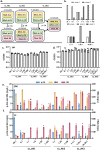Modular Metabolic Engineering and Synthetic Coculture Strategies for the Production of Aromatic Compounds in Yeast
- PMID: 37218844
- PMCID: PMC10278174
- DOI: 10.1021/acssynbio.3c00047
Modular Metabolic Engineering and Synthetic Coculture Strategies for the Production of Aromatic Compounds in Yeast
Abstract
Microbial-derived aromatics provide a sustainable and renewable alternative to petroleum-derived chemicals. In this study, we used the model yeast Saccharomyces cerevisiae to produce aromatic molecules by exploiting the concept of modularity in synthetic biology. Three different modular approaches were investigated for the production of the valuable fragrance raspberry ketone (RK), found in raspberry fruits and mostly produced from petrochemicals. The first strategy used was modular cloning, which enabled the generation of combinatorial libraries of promoters to optimize the expression level of the genes involved in the synthesis pathway of RK. The second strategy was modular pathway engineering and involved the creation of four modules, one for product formation: RK synthesis module (Mod. RK); and three for precursor synthesis: aromatic amino acid synthesis module (Mod. Aro), p-coumaric acid synthesis module (Mod. p-CA), and malonyl-CoA synthesis module (Mod. M-CoA). The production of RK by combinations of the expression of these modules was studied, and the best engineered strain produced 63.5 mg/L RK from glucose, which is the highest production described in yeast, and 2.1 mg RK/g glucose, which is the highest yield reported in any organism without p-coumaric acid supplementation. The third strategy was the use of modular cocultures to explore the effects of division of labor on RK production. Two two-member communities and one three-member community were created, and their production capacity was highly dependent on the structure of the synthetic community, the inoculation ratio, and the culture media. In certain conditions, the cocultures outperformed their monoculture controls for RK production, although this was not the norm. Interestingly, the cocultures showed up to 7.5-fold increase and 308.4 mg/L of 4-hydroxy benzalacetone, the direct precursor of RK, which can be used for the semi-synthesis of RK. This study illustrates the utility of modularity in synthetic biology tools and their applications to the synthesis of products of industrial interest.
Keywords: combinatorial engineering; division of labor; microbial communities; p-coumaric acid; raspberry ketone; synthetic biology.
Conflict of interest statement
The authors declare no competing financial interest.
Figures



References
-
- Borejsza-Wysocki W.; Hrazdina G. Biosynthesis of p-hydroxyphenylbutan-2-one in raspberry fruits and tissue cultures. Phytochemistry 1994, 35, 623–628. 10.1016/S0031-9422(00)90575-2. - DOI
Publication types
MeSH terms
Substances
Grants and funding
LinkOut - more resources
Full Text Sources
Molecular Biology Databases

